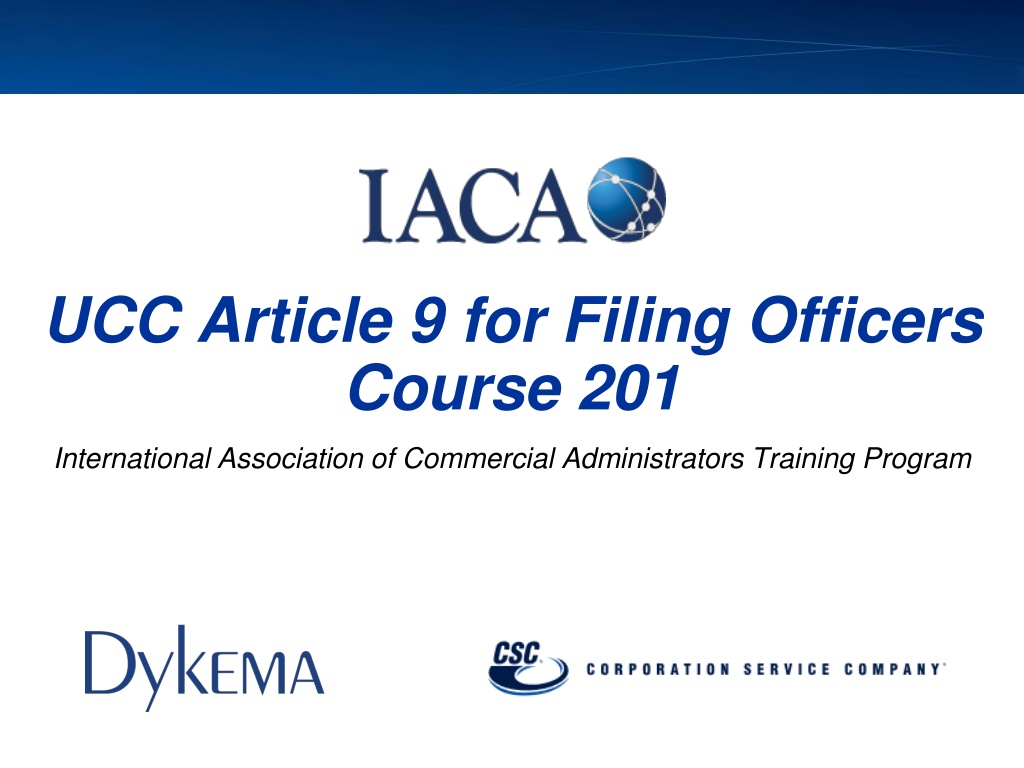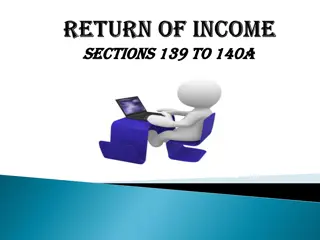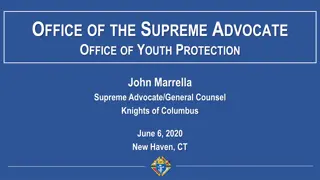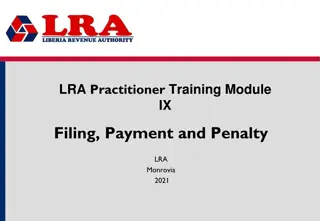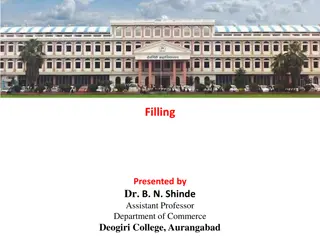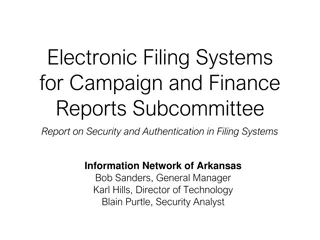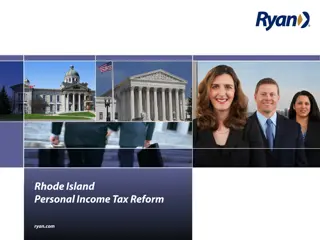Understanding UCC Article 9 Filing System
The UCC Article 9 filing system plays a crucial role in perfecting security interests and providing public notice for creditors' rights adjustments. It emphasizes the importance of proper filing, searchers' due diligence, and the neutral role of the filing office in maintaining accurate records. Key concepts, responsibilities, and biases within the system are highlighted to ensure a clear understanding of its operations.
Download Presentation

Please find below an Image/Link to download the presentation.
The content on the website is provided AS IS for your information and personal use only. It may not be sold, licensed, or shared on other websites without obtaining consent from the author. Download presentation by click this link. If you encounter any issues during the download, it is possible that the publisher has removed the file from their server.
E N D
Presentation Transcript
UCC Article 9 for Filing Officers Course 201 International Association of Commercial Administrators Training Program
UCC Article 9: Quick Review
UCC Article 9 Background Role of the Filing System Because Article 9 allows parties to adjust other creditors rights by private agreement, fairness requires public notice To achieve priority, a security interest must be perfected Filing a financing statement is by far the most common method to perfect Repository for UCC Financing Statements As a neutral third party, government is in the best position to provide a stable repository for notices filed under the UCC. UCC records are maintained by the designated government unit for commercial use, not for the benefit of government.
Essential UCC Filing System Concepts UCC is a just a Notice Filing System UCC records do not establish ownership or rights. Financing statements are not signed and are not enforceable documents Financing statement merely notice that a security interest may exist. So, Searchers Must Conduct Further Inquiry Article 9, case law and commentary all indicate that searchers must contact the parties involved to learn the full state of affairs. UCC Places the Burden on Filer to Get it Right Must satisfy all the content requirements. Filing office is not responsible for legal sufficiency.
Role of the Filing Office The Filing Office is a Trusted Repository Relied upon by searchers to identify or confirm the absence of security interests perfected by filing Key responsibilities are: Maintaining a stable database Proper indexing Maintain search logic that yields consistent results Responsibilities are Purely Ministerial Article 9 policy is to remove judgment and discretion from the filing office's duties. Filers and searchers are responsible to protect themselves while the filing office remains neutral Filing office concern is with the maintenance, not the effectiveness of records.
Role of the Filing Office Article 9 Has a Bias in Favor of Filing Filing office may only refuse to accept a record for a reason specified in statute. Perfect tender of filing and fee constitutes filing, so rejection for improper reason results in a perfected security interest hidden from searchers and potential tort liability for filing office. Searching: UCC Article 9 Open Drawer Policy Filing office must provide the entire record history to searchers. All amendments linked to initial financing statement by file number Searchers are responsible for interpretation.
Key Operating Principles Intake: Do No Harm Because filing office cannot know in fact what is going on, filing office maintains debtor names and secured parties of record even if amendments indicate changes. Amendments accepted until lapse, even if apparent termination by or deletion of authorizing party Once a secured party of record, always a secured party of record Searches: Maintain Consistent Results Legal sufficiency of debtor name is based on practical search results, so standard search logic outcomes should not change over time Legal result is unclear
UCC1 Assignment Using UCC1AD Form
UCC1 Reflecting Assignment Purpose Indicates an assignment of all of the secured party s power to authorize an amendment of the financing statement. A UCC1 Assignment is always a full assignment. Filer s Perspective - How Indicated Assignee secured party is listed in Item 3 of the UCC1 form or electronic record. Assignor secured party is listed in Item 11 of the UCC1AD or equivalent electronic record and the ASSIGNOR SECURED PARTY S NAME box is checked. Effect of UCC1 Assignment Party listed in Item 3 of the UCC1 is the secured party of record. UCC 9-511(a) (Emphasis added). Party listed in Item 11 is not a secured party of record.
UCC1 Reflecting Assignment Filing Office Intake: Form of Assignor Secured Party name is not a reason for rejection under 9-516(b). Form of Assignor Secured Party address or omission of address is not a reason for rejection under 9-516(b). Omission of name or address is a reason for rejection with respect to the Assignee only. Filing Office Statutory Indexing Requirements Normal indexing rules under 9-519 apply. Filing Office Actual Indexing Practices Filing office does not control whether the Assignor Secured Party is a secured party of record.
UCC1 Reflecting Assignment A good idea improperly implemented? Supposed to be good for structured financing and other transactions where initial secured party (in many cases a buyer of rights to payment) also grants security interest Intended to avoid having to provide UCC1 and incomplete UCC3 with filing instructions Problem is initial secured party never becomes a secured party of record and is (likely) never perfected If initial secured party is never perfected, then why include on financing statement at all? How many of these are seen?
UCC-3 Assignment Assigns Right to Amend the Financing Statement A UCC-3 assignment does not assign the security interest! SP of record might be a secured party representative (who need not indicate such status) Effect of UCC3 Assignment: Adds the assignee as secured party of record. Assignment may be full or partial but UCC3 need not so indicate. Assignor remains a secured party of record. See 9-511(c). If desired, assignor may file an amendment to delete itself as a secured party. But assignor is treated as a secured party of record as far as filing office is concerned under the Do No Harm rule. And so is deleted secured party if they file a subsequent amendment
UCC3 Assignment Purpose Indicate an assignment of some or all of the secured party s power to authorize an amendment of the financing statement. Filer s Perspective - How Indicated Check Item 3 of the UCC3 form or an equivalent electronic record. Provide Assignee name and address in Item 7 of the UCC3 form or an equivalent electronic record. Provide name of Assignor in Item 9 as secured party authorizing the amendment. Filer s Perspective - Additional Info for Partial Check ASSIGN collateral box in Item 8 of the UCC3 form or an equivalent electronic record. Provide description of collateral subject to secured party s powers .
Assignment Assignee Secured Party
Assignment Assignor Secured Party
UCC3 Assignment: Indexing Indication (full or partial) Not required. Failure to indicate is not a reason for rejection in 9-516(b). Assignee Assignee must be added as a secured party of record. Assignor No indexing change required. Assignor remains a secured party of record. Collateral Contents of Item 8 must be reflected in the record for electronic filing. No need to enter collateral data for written record.
Termination Statement Purpose & Statutory Effect Indicates that a financing statement is no longer effective. Termination is effective only to the extent that a secured party of record authorized the filing. 9-510(a) & 9-509(d)(1). This was the issue in the Motors Liquidation case, and will be litigated again. But, filing office cannot possibly determine effectiveness of a termination statement, so accept but Do No Harm. Effectiveness of Debtor Authorization The debtor may authorize the filing of an effective termination statement following compliance with specific statutory requirements set forth in 9-513. 9-509(d)(2). Filing office cannot determine effectiveness of termination statement filed by a debtor.
Termination Statement Filers Perspective Initial Financing Statement File Number Provided in Item 1a. Indication that Record is Termination Statement Provided by checking box in Item 2. Name of Debtor Commonly provided in UCC3 Item 6 or Item 10 for reference purposes only. Does not indicate that termination applies solely to listed debtor. Name of Secured Party Authorizing the Amendment Generally is provided as the name of the existing secured party of record, but that is not necessary. Best practice is to be clear and use as successor, as assignee, n/k/a or f/k/a (or the like) as appropriate.
Termination Statement Filing Office Duties Rejection Reasons: 9-516(b) Initial financing statement file number does not match an unlapsed financing statement. NOT Reasons for Rejection 9-520(a) Debtor name omitted. Secured party name omitted in Item 9 or does not match a secured party in the UCC information management system. Filing Office Indexing Termination statements should be indexed as other amendments. Termination statements have no effect on the lapse date. Filing office must accept multiple termination statements. Amendments are effective only with respect to the authorizing secured party(ies). UCC 9-510(b).
Termination Statement Filing Office Duties Amendment After Termination Statement Filed Filing office has no grounds to reject an amendment after a termination statement has been filed under the Do No Harm rule. Filing office cannot know whether or to what extent a termination statement is effective. Continuation After Termination Statement Filed Filing office has no grounds to reject a continuation statement submitted after a termination statement has been filed under the Do No Harm rule. Filing office cannot know whether or to what extent a termination statement is effective. Filing office should index the continuation statement and reset lapse date as provided in 9-515(a) unless other grounds for rejection exist under 9-516(b).
Continuation Statement Purposes 1. Extend Effectiveness of Record The timely filing of an authorized continuation statement extends the effectiveness of the financing statement to which it relates for an additional 5-year period. 9-515(e). Effectiveness is not a filing office concern. 2. Extend Duration of Record in Searchable Index Filing office must index continuation statement and extend the lapse date by 5 years calculated from the date the record would have lapsed absent the filing. Indexing a continuation statement does not necessarily extend the effectiveness of the record.
Continuation Statement Filers Perspective Initial Financing Statement File Number Provided in Item 1a. Filers often provide the file date in Item 1a following the initial financing statement file number on written forms. Indication that Record is Continuation Statement Provided by checking box in Item 4. Name of Debtor Commonly provided in UCC3 Item 6 or Item 10 for reference purposes only. Does not indicate that continuation applies solely to listed debtor. Name of Secured Party Authorizing the Amendment Generally is provided as the name of the filing party, but that is not necessary.
Continuation Statement Time for Continuation Statement Filing: A filing office must reject a continuation statement submitted more than 6 months prior to, or at any time after the lapse date. See 9-516(b)(7). 6-month window is strictly construed no force majeure relief, though MARs clarifies first and last day are OK. A continuation statement accepted outside the 6-month window is ineffective, even if the filing office resets the lapse date. Multiple Continuations: Filing office does not have grounds under 9-516(b) to reject additional continuation statements submitted for filing within 6 months prior to the lapse date. Refusal of additional continuation statements may significantly harm a secured party or those who search the UCC index.
Continuation Statement Filing Office Duties Rejection Reasons: 9-516(b) Initial financing statement file number does not match an unlapsed financing statement. NOT Reasons for Rejection 9-520(a) Debtor name omitted. Secured party name omitted in Item 9 or does not match a secured party in the UCC information management system. A continuation statement has already been filed. A termination statement has already been filed. Filing Office Indexing Continuation statements should be indexed as other amendments. Lapse date is reset with first continuation statement to 5 years from the date the record would have lapsed absent the filing.
UCC5 Information Statement Purpose Allows a person to provide information about the record, often to indicate that the effectiveness or scope of the record is in dispute. Intended to protect third parties (those who search the records). Warns that prior filing may be inaccurate. Statutory Effect of Filing None. The filing of an information statement does not affect the effectiveness of an initial financing statement or other filed record. 9-518(e). Nor does it amend a financing statement in any way. Filing Office Indexing Strong bias in favor of filing if information necessary to index (i.e., file number of initial financing statement) is provided.
UCC5 Information Statement Who files one? SP who discovers unauthorized amendment was filed Number of cases where termination statements were supposedly filed prematurely SP who provided mistaken file number on amendment. Debtor who is victim of bogus filing, or of overbroad collateral description No other remedy for debtor who is victim of overbroad filing.
Other Issues Electronic Filing System Should Duplicate all Form Actions Filers are frustrated if they cannot perform all actions online or through XML that they can using written forms. Exception: real estate actions and information. Capability for Attachments Essential to gain support of legal profession. Reasons for Rejection Should Be Consistent Article 9 is intended to be medium neutral, and reasons for rejection are strictly limited. 9-516(b) does not distinguish between written and electronic records.
Other Issues Electronic Filing Reasons for Rejection Must Be Provided Too many electronic filing systems do not provide a printable screen shot of 9-516(b) reason why the system will not allow the user to submit record . Pre-filing Review Issue In many cases, financing statements need to be reviewed for opinion or quality control issues prior to filing. How to ensure what is reviewed (almost always hard copy) is what gets filed? Service companies currently provide hold for review capability today.
Other Issues Transmitting Utilities Transmitting Utility Financing Statements do not have a lapse date. They lapse only when all secured parties of record have filed termination statements. How does filing office know when that has occurred? Filing office does not know if terminations are properly authorized or not. Consensus seems to be that TU financing statements are not lapsed unless and until someone asks for it. Filing office should have a written procedure reflected in administrative rules. Filers might consider assignment to next in line
Other Issues Standard Search Logic Standard Search Logic ( SSL ) needs to yield consistent results over time. 9-506 makes SSL the arbiter of debtor name adequacy and, therefore, legal effectiveness. Legal outcomes in issue if expansion of SSL causes previously ineffective financing statement to be found, or if retraction of SSL causes effective financing statement to no longer be found. SSL does not find federal tax liens and other filings in filing office where filer does not need to meet Article 9 debtor name standard Expanded non-standard search logic can help, but filing office needs to carefully and consistently distinguish SSL from alternatives.
Future Issues Is there a better SSL (assuming transition rules)? Old rules based on thinking from early 1990 s. E.g., eliminating the at the beginning or organization names. Name ending rule does not provide relief if there s a typo in a name ending. How much wiggle room should filer get? What about point and click for registered organizations? For UCC filing and searching business and UCC records simultaneously.
Q&A Thank You!
Contact Information: Paul Hodnefield Associate General Counsel Corporation Service Company Dykema Gossett PLLC 2345 Rice St., Ste. 230 Roseville, MN 55113 800-927-9801,ext. 61730 Cell: 952-649-1555 phodnefi@cscinfo.com Darrell W. Pierce Member 2723 S. State St., Ste. 400 Ann Arbor, MI 48103 734-214-7634 734-355-4452 dpierce@dykema.com
